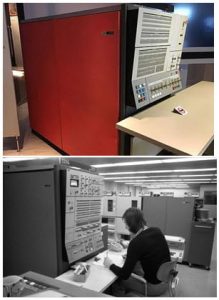IBM 360/40 computer
Of the systems introduced to the market in the 1970s, the IBM 360 family of machines clearly had the greatest impact on the development of computing.
Due to strict embargo restrictions, only the 360/40 model (top image) was available in Hungary, so only these machines had practical significance for us, which is why we are introducing this model.
(The image below shows a typical computer room configuration.)
Use
Examples without claim to be exhaustive:
- Development of corporate information systems
- Scientific and technical calculations
- Process control
- Remote data transfer, terminal functions
The 360/40 model has become widespread in Hungary
- In Hungary: Informatics History Exhibition
- USA-ban: Computer History Museum
Structure
Central unit
Byte-organized machine: 8 bpB
- control unit:
- IBM2040 architecture, clock speed 1.33 MHz
- single and dual address instruction system
- main store:
- 8-256 KB ferrite ring RAM, 32 KB memory blocks
- (parity bit) error protection function
- 8-256 KB ferrite ring RAM, 32 KB memory blocks
- channel:
- selector channel for back-up storage
- multiplex channel for other external devices
- data transfer controller: IBM 2701
Periphery
- backups:
- IBM 1311 magnetic disk units
- 7.25 MB disk packs IBM 1316 or IBM 2316
- direct access disk drive (IBM 2314)
- IBM 3420 magnetic tape drives
- 7-lane (180 / 181)
- 9-band (182 / 183)
- IBM 1311 magnetic disk units
- external devices:
- control console: IBM 1502 (interchangeable) ballpoint typewriter
- optical reader
- IBM 2540 punched tape reader and puncher
- IBM 1442 punched card reader and puncher
- IBM 1403 line printer, 32 chpl, 600-1100 lpm
The replaceable ball head or writing chain is a much cheaper and simpler technical solution than the fixed letter arm or the rotating cylinder, but it is also advantageous because by replacing both the ball head and the chain, it is easy to switch to different coded character sets (Latin, Cyrillic, Greek, etc.) and font types (lowercase or italic letters, mathematical symbols, etc.).
Operation
Instruction length 1, 2 or 4 B
Handling 3 types of data :
- text data: 8 bits (1 B)
- fixed-point number: halfword (16 bits) or machine word (32 bits)
- floating point number: double word (64 bits)
Operating speeds:
- decimal addition: 24600 ips
- fixed-point addition: 0.1333 Mips
- fixed point multiplication: 12600 ips
- fixed point resolution: 5400 ips
- general purpose register operations: 1.25 μs
- floating point register operations: 2.5 μs
Main store cycle times:
- RAM. 2.5 μs (16 bits each)
- ROM 625 μs
Data transfer speeds:
- selector channel: 400,000 chps
- multiplex channel: 31,000 chps
Special instructions supporting multiprogramming
In more detail: IBM 360/40 operating manual (English)
Program set
- operating systems:
- DOS (Disk Operating System) for disk machines, with any number of partitions
- OS MFT – for magnetic disk machines, with a fixed number of partitions
- BPS (BASIC Programming System) disk system including a BASIC compiler
- TOS (Tape Operating System) for magnetic tape systems
- compilers:
- assembler
- Fortran
- Cobol
- PL1 (Programming Language 1)
- RPG (Report Program Generator)
Historical curiosities
The IBM 360 family of machines formed a universal system, so its members could be used to solve all tasks, from scientific and technical calculations to data processing and process control to remote data processing. Accordingly, IBM's range of external (peripheral) devices was also very wide. 300 patents were used in its development.
In fact, this family of integrated circuits gave birth to modern computing. Its application – by merging the punched card and punched tape standards – created the internationally accepted, standardized character code tables that are still used today, not only in 9-track magnetic tape drives, but also in keyboards, monitors, and other input/output devices.
We note that the IBM 360 family of computers also served as a model for the Unified Computer System (https://itf.njszt.hu//wp-content/uploads/AG_ESZR_6.pdf) developed in socialist countries.
Resources
Brief introduction: IBM 360/40 (video)
360 model list: System 300 (English)
The history of the development of the machine family: Inside IBM
Created: 2016.04.27. 23:21
Last modified: 2021.01.04. 19:55

